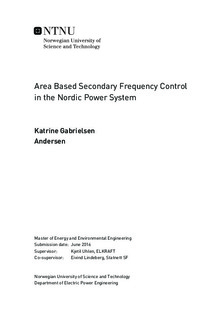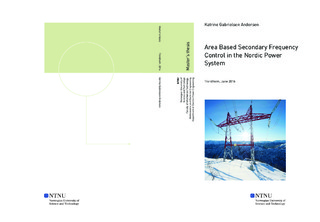| dc.description.abstract | In order for a power system to function properly, it is necessary that the power production is equal to the power demand at all times. The next day's power balance is scheduled by the transmission system operators (TSO's) as a result of what the power consumers and producers declare they want to buy and sell. However, unpredictable events are bound to happen. Therefore there are additional controls using three frequency reserve markets; primary, secondary, and tertiary reserves. The focus in this master's thesis is secondary frequency control, which uses Automatic Frequency Restoration Reserves (aFRR).
Today there is one central proportional-integral controller handling the secondary frequency control of the entire Nordic power system. In this thesis a design and analysis of an alternative control structure is presented. A simplified version of the Nordic synchronous system comprising eleven areas is modeled using Simulink. The areas consist of one generator in accordance with the installed power generation per area, and one load equal to the value during an actual high load hour. The model uses a combination of the swing equation and DC power flow to do the network calculations. Three Automatic Generation Controllers (AGC's) are included in the system for decentralized secondary frequency control. The input to the controllers is the frequency deviation, and the power flow and capacities in specific tie lines between the areas; while the output is the change in power production.
The AGC's are modeled as classical AGC's with a few modifications. The most important modification of the AGC's is that the tie line power flow is only taken into account when the power flow in the tie lines exceed the capacity limits. In other words, the Area Control Error (ACE) only regards the system frequency and is common for the entire system as long as there are no congestions in the controlled tie lines. The system is split into two or more areas operating with individual ACE's when congestions occur.
The activation of secondary frequency control is based on a merit order list comprised of available volumes and prices of the aFRR in each bidding zone. Hence, the control structure makes sure that when disturbances occur, the cheapest available aFRR is activated. The activation depends on whether there are any congestions. When the power transfer in any of the tie lines exceed the capacity limits, aFRR is instead activated in areas where the congested line is not a hindrance.
As secondary frequency control is relatively new in the Nordic power system, it is currently paid for by all the Nordic TSO's. By implementing AGC's in all bidding zones, the areas experiencing disturbances will be the ones actually paying for frequency restoration by purchasing the cheapest aFRR available. The Nordic countries and areas would be in control of their own ACE, in addition to cooperating by buying and selling aFRR.
One of the simulated cases in this thesis shows that AGC's in only three areas is not enough because other than the three controlled tie lines may be congested. If the proposed solution is to be implemented in the Nordic power system, an important challenge in the control structure is to control as many tie lines as possible in order to make sure that no grid capacities are exceeded. | |

